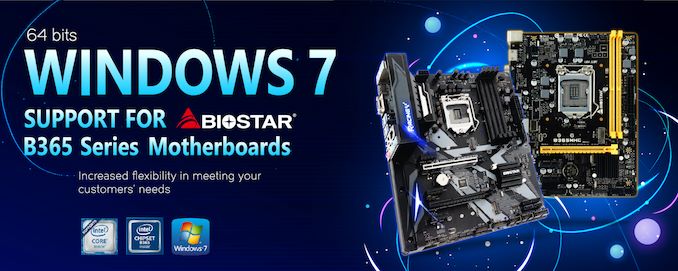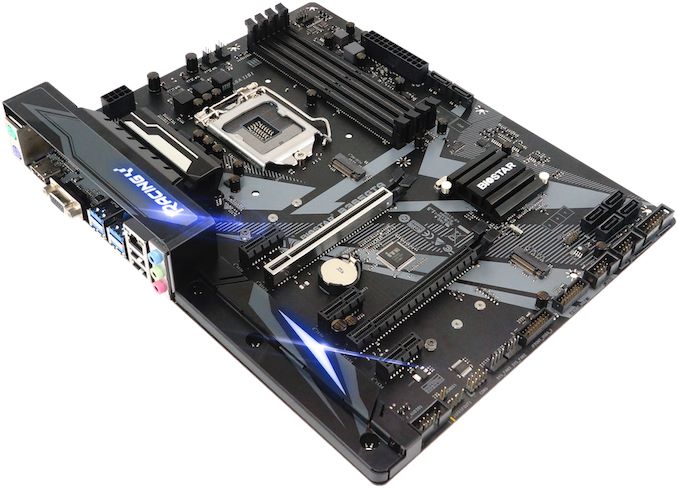BIOSTAR Brings Windows 7 To Intel's B365 Platform: A Core i9-9900K w/ Win7, Anyone?
by Anton Shilov on February 20, 2020 1:30 PM EST- Posted in
- Motherboards
- Intel
- Biostar
- Windows 7
- B365

Even though Microsoft ended regular support for Windows 7 last month, there are millions of customers who continue to use the OS and plan to stick with it for a while to come. But even without essential security updates, trying to use Windows 7 in 2020 comes with an even bigger roadblock: most modern platforms aren't supported by the OS, which limits upgrades and replacement hardware to badly outdated parts. So, in an effort to continue supporting customers who want to use Windows 7 no matter what, BIOSTAR has found a way to install Windows 7 on its B365 chipset-based motherboards, which opens doors to new Windows 7-powered desktops with Intel's latest-generation CPUs.
Released in 2009, Microsoft Windows 7 does not support a host of technologies supported by the latest platforms, which is why Microsoft cut off new hardware support for Windows 7 starting with AMD’s Ryzen and Intel’s Kaby Lake (7th gen Core) platforms. Reciprocally, neither AMD nor Intel officially support Microsoft’s legacy operating systems with drivers for their latest platforms. As a result, while it's not impossible to install Windows 7 on newer hardware, it's certainly something that is discouraged at multiple levels.
But since it's not impossible, BIOSTAR has gone ahead and put together a special tool to simplify the process for users. The tool automatically adds Intel B365-specific features to a Windows 7 SP1 installation image, allowing the OS to be installed on the platform.
Overall, BIOSTAR's method overcomes the three key blocks that prevent Windows 7 from being installed on a new platform: the lack of UEFI loader, an xHCI driver for USB 3.0, and an NVMe driver. These problems can already by surmounted if you know what you're doing, but this is the first time we've seen a manufacturer so directly attempt to support Windows 7 on newer hardware via an easy-to-use method, and thus far BIOSTAR is the only company doing this. Not that it isn't without some peculiarities (described here), but support is support all the same.
BIOSTAR has two Intel B365-based motherboards that can use Windows 7: the ATX form-factor Racing B365GTA aimed at gamers, as well as the Micro-ATX B365MHC targeted at mainstream users. The former supports virtually all Intel LGA1151 processors, including the cream of the crop eight-core Core i9-9900K, whereas the latter can work with chips up to Intel’s eight-core Core i7-9700K.
Overall, BIOSTAR's decision to base their support around the B365 chipset is a curious one on the surface, but something that makes more sense as you dig into the chipset. While Intel’s B365 PCH is a part of the 300-series chipset family, the chipset is essentially a holdover from Intel's earlier 200 series chipsets, and has much more in common with them. So supporting Windows 7 on B365 is much less of a stretch than on Cannon Point chipsets like B360, as BIOSTAR doesn't have to worry about things like Intel's updated USB 3.1 Gen 2 controller or CNVi wireless support.
Related Reading:
- Intel Adds B365 Chipset to Lineup: The Return of 22nm
- BIOSTAR Adds Windows 7 Support To Some Intel and AMD Motherboards
- CES 2019: ASRock's Five New B365 Motherboards
- Microsoft Brings DirectX 12 To Windows 7
- Intel Preps New H310 Chipset Revision With Windows 7 Support For Coffee Lake
- How To Get Ryzen Working on Windows 7 x64
Source: BIOSTAR (via TechPowerUp)











49 Comments
View All Comments
baka_toroi - Thursday, February 20, 2020 - link
Awesome! Thanks, Biostar!mooninite - Thursday, February 20, 2020 - link
Please do us all a favor and install a Linux distribution.baka_toroi - Thursday, February 20, 2020 - link
Linux is a piece of shit and will always be.RadiclDreamer - Thursday, February 20, 2020 - link
While i dont like it as a desktop OS, and its especially not ready for gaming you are out of your mind if you think its a POS. Just about every web server in the world runs linux, you will be hard pressed to find a way to be online today without having (unknowingly) used linux several times.baka_toroi - Thursday, February 20, 2020 - link
Does this motherboard look like a server board? Your comment is off-topic.LauRoman - Thursday, February 20, 2020 - link
Any motherboard can be a server board. The board of your router is a server board, and it serves dhcp and even dns redirects (if so configured).You are, however, a buffoon.
inighthawki - Thursday, February 20, 2020 - link
I don't really think Linux works too well in desktop/workstation environments, but in the server environment, Linux is king. It's reliable, lightweight, and *highly* configurable - not to mention free. The downside is that if you don't know what you're doing you can mess up quite a bit.I run a small home server with some containers and VMs and truthfully Windows would suck at doing what I want it to do.
Whiteknight2020 - Thursday, February 20, 2020 - link
Windows would probably not suck at what you are trying to do. Server core, docker, windows containers and C# make for a cleaner stack than anything with the monstrosity that's java in it. Not knocking Linux, but they both do lots of jobs very well, and some they are crap at. I just wish big red would put some more effort into Solaris, which is absolutely rock solid and a marvelous platform for messaging apps. Horses for courses.inighthawki - Thursday, February 20, 2020 - link
I have not had a good experience with windows containers in the past, and they have a number of limitations such as being tied to the OS version (for process isolated containers, not hyper-v containers, of course). I've also become much more fond of Linux's network stack.Hyper-v is also missing functionality I wanted for VMs such as USB-passthrough. This is just a completely unsupported scenario and I think the only thing close is to find a PCIe based USB controller compatible with IOMMU passthrough, which from my experience looking has been very limited and the ones that do work can be a bit... flaky.
I am a fairly Windows-y guy, and I originally started the build I planned to use Hyper-V Server but over time I just found Linux to be much better for what I ended up doing.
inighthawki - Thursday, February 20, 2020 - link
Also worth noting that .NET core is now cross platform and so C# is becoming more common even on Linux :)